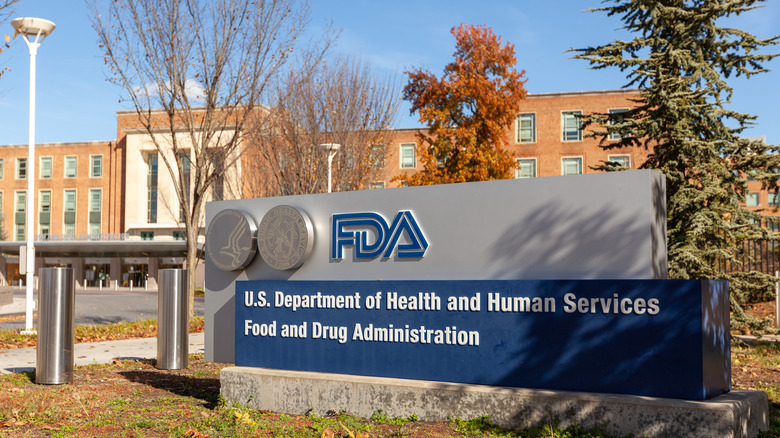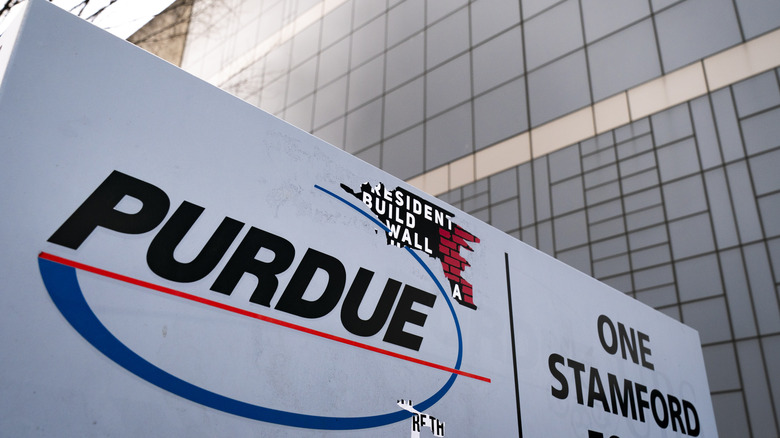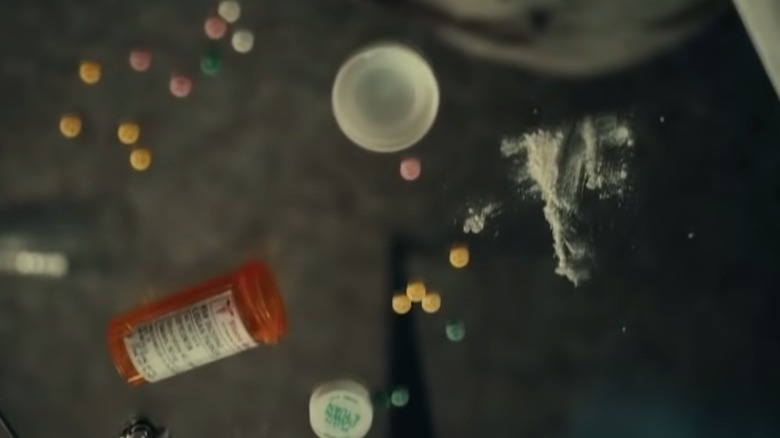The True Story Behind Dopesick
Spoiler alert: This article contains spoilers for the Hulu Limited Series "Dopesick."
"Dopesick," an eight-part series now available to stream on Hulu, deals with the ongoing opioid addiction crisis which has taken the lives of an estimated 500,000 Americans since the 1990s (via NPR). As NPR notes elsewhere, the show is based on the non-fiction book "Dopesick: Dealers, Doctors and the Drug Company that Addicted America" by investigative journalist Beth Macy. Macy's work focused on the effects of the drug OxyContin, developed and marketed by the company Purdue Pharma, on those living in the Appalachian region south of New York, and puts the spotlight on those responsible for the deadly pandemic.
Entertainment Weekly has described the show as "an American horror story that's all too real," and praised its unerring depiction of the effects of what elsewhere has been called the "crime of the century" (via HBO) as well as the understated, empathetic performances of its stellar ensemble cast. Michael Keaton stars as Dr. Samuel Finnix, an Appalachian doctor who is convinced by an employee of Purdue Pharma to prescribe to his patients, and who subsequently becomes addicted to the pain-relieving opioid. Speaking with Entertainment Weekly, Keaton explained his ambitions for the show: "I hope it shines a light on the opioid situation and how big pharma operates."
"Because we were documenting the crimes of Purdue Pharma, the show needed to feel as real as possible," Macy told NPR.
Richard Sackler and the birth of OxyContin
As The Guardian notes, the show unfolds in "three strands." One concerns the real-life company Purdue Pharma and its billionaire president, Richard Sackler. In "Dopesick," Sackler is brought to the screen by regular Coen Brothers collaborator Michael Stuhlbarg, who plays him "with the creepy intensity of a Bond villain," per NPR critic Eric Deggans, a portrayal that numerous commentators on the opioid crisis, including Beth Macy, would surely agree is apposite.
Sacker's father, Raymond, bought Purdue Pharma in 1952, along with his brother, Mortimer. Both were doctors, and the two shared options in the company with their older brother, Arthur, a psychiatrist. According to The New Yorker, Arthur passed on the belief to the younger Sacklers that they should "Leave the world a better place than when you entered it." In the second half of the 20th century, the Sackler name became synonymous with philanthropy and patronage of the arts, while they expanded their wealth to become one of the richest families in America.
But the actions of Richard Sackler would see the family rebranded in the 21st century as "the family that built an empire on pain," per The New Yorker. As Stat describes, in the late 1980s Sackler, who was then assistant to his father, the president of Purdue Pharma, concocted a scheme by which to circumvent the company's bestselling opioid painkiller, MS Contin, going off-patent. Sackler oversaw the reformulation the drug with a newly-developed coating that supposedly gave the drug a slow release action and reducing the risk of opioid addiction, and rebranding it as OxyContin.
Why did the FDA approve OxyContin?
As depicted in "Dopesick," the claims of Richard Sackler and Purdue Pharma concerning OxyContin's reduced addictive properties proved to be far from the truth. Like other opioids, OxyContin remained a highly addictive and deadly drug, which doctors should have been hesitant about prescribing for their patients. But one key component seemed to validate the company's unbelievable claims in the eyes of many: The newly-packaged painkiller had been approved by the U.S. Food and Drug Administration (FDA). Over the years, many have asked how this was allowed to happen. But today we have a simple, infuriating answer: corruption.
As shown in the FDA's own documents, OxyContin was first approved as "safe and effective" for moderate use in 1995 (via Judge For Yourselves). This was just the first of a number of what the AMA Journal of Ethics describes as "regulatory mistakes" which were allowed to happen concerning the new opioid, with the FDA only providing warnings once the drug was already being widely prescribed.
According to Business Insider, a new book by Patrick Radden Keefe, titled "Empire of Pain: The Secret History of the Sackler Dynasty," revealed that FDA director Curtis Wright, who oversaw the initial approval of OxyContin in 1995, left the administration the following year, to take up a job in the private sector worth $400,000 a year. The company? Purdue Pharma.
The truth of Dr. Samuel Finnix
Richard Sackler would go on to become president of Purdue Pharma in 1999, by which time OxyContin had a stranglehold on the prescription painkiller market while creating a wave of opioid addiction among its users. As The New York Times reports, Sackler was responsible for aggressively marketing the drug as a non-addictive option for chronic pain, a misleading claim that he managed to push by citing the drug's approval in 1995 by the FDA.
In an interview with USA Today, Michael Keaton described the pleasure he took in portraying Dopesick's lead character, Dr. Samuel Fennix, saying that the quality of the writing on the show meant that there was very little he had to invent himself. Fennix is depicted as a hard-working doctor who has his patients' best interests at heart, but who, despite his initial misgivings, is won over by the compelling pitch of Billy Cutler (Will Poulter), a Purdue Pharma salesman pushing OxyContin on unsuspecting doctors.
But was Dr. Finnix's story true? Yes and no. The creators of "Dopesick" have claimed that the character is emblematic of the situation many doctors across America found themselves in as a result of Purdue Pharma's deception, while the story of Finnix's own addiction was informed by that of Dr. Stephen Lloyd, a Tennessee doctor who developed a 100-pill-a-day addiction to OxyContin before becoming a commissioner in the state's substance abuse services department and a vocal campaigner in the battle against opioid addiction (via the Tennessean).
Investigating the Sackler family
Just as they do in "Dopesick," the Drug Enforcement Administration (DEA) began their investigation into the Sackler family and Purdue Pharma soon after OxyContin went to market, though it is only in recent years that corruption and the Purdue Pharma's reckless promotion of the dangerous opioid, despite the public health risk it posed, have come to light.
In September 2021, the Sackler family agreed to a bankruptcy plan in which they relinquish control of Purdue Pharma as part of a $10 billion settlement that included compensation for many of the company's victims, according to The Guardian. But many critics have claimed that the judgement effectively alleviates the Sackler family of personal responsibility, even as their reputation and finances take substantial blows. Even in August 2021, Richard Sackler defiantly testified that his family "bears no responsibility" for the opioid crisis, according to The New York Times. It is unlikely the family will ever be held accountable. "Dopesick" showrunner Danny Strong has claimed, "This series is the trial that should have happened" (per The New York Times).
Bloomberg reports that the Sackler family's fortunate is still estimated to stand in the region of $11 billion.
The opioid addiction epidemic continues
"Dopesick" has been roundly praised for its realism. It depicts the real-life consequences of Purdue Pharma's irresponsible marketing of OxyContin to blameless doctors who prescribed the drug to their patients without the foreknowledge of its destructive addictive properties. Yet some commentators have noted the show's shortcomings when it comes to portraying people of color dealing with the same issues.
As NPR's Eric Deggans has noted, the show's rural Appalachian setting means that the episodes almost exclusively focuse on white victims of the opioid epidemic. But the truth is that the opioid crisis and the ensuing drug overdose pandemic have disproportionately affected non-white communities in the U.S. As noted by KQED, racial bias means the problems of these communities remain underreported, while Black Americans are more likely to face incarceration in the face of fewer safety nets and services through which to combat the effects of addiction.
As NPR reported in September 2021, opioid death rates among African Americans are growing significantly faster than among the general population, with a 38% increase in contrast to an apparent plateau among other communities. The writers of the study have called for an "antiracist public health approach" to the crisis, stating there has been a "shift in the demographics" since the events depicted in "Dopesick" took place. Sadly, the American opioid epidemic is far from over, but shows like "Dopesick" thankfully mean that we continue to talk about it.





